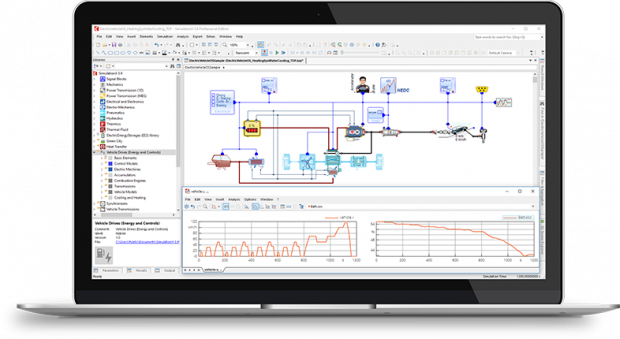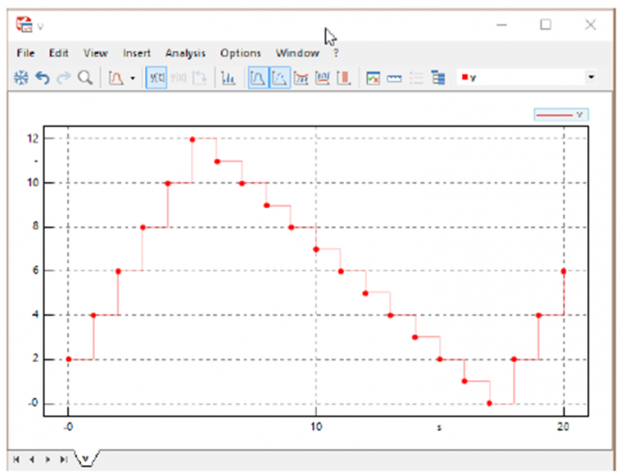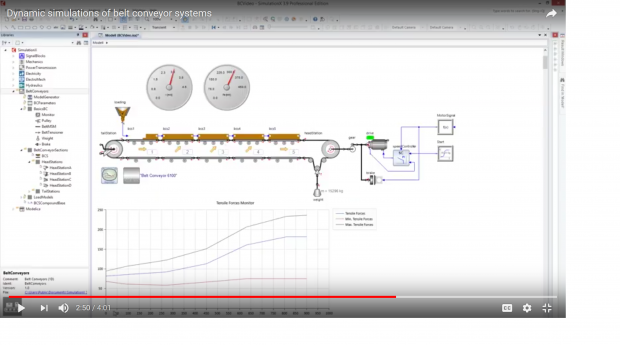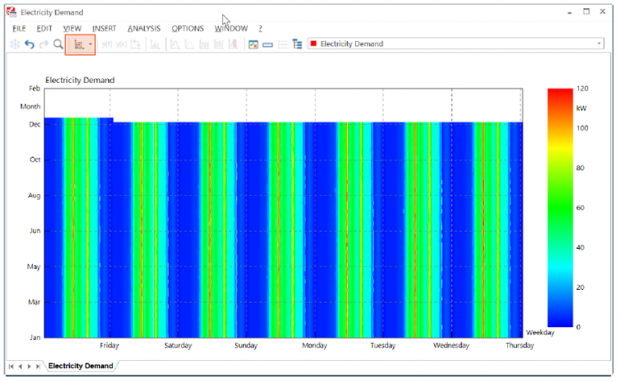
ESI Group has released version 3.9 of its SimulationX platform for multiphysics system simulation. Shown here is an electric vehicle simulation that includes WLTP (Worldwide Harmonized Light Vehicle Test Procedure) driving cycle, cooling system for the battery and the electric machine as well as other data. Image courtesy of ESI Group.
Latest News
December 28, 2017
ESI Group has announced the 3.9 release of SimulationX, its software platform for multiphysics system simulation. Key highlights cited by the developer include Modelica Synchronous language elements, new libraries as well as improved calculation methods and enhanced results visualizations. Compared to its predecessors, version 3.9 also is said to model, calculate and analyze more quickly as well as offer higher performance in handling large models.
ESI says that the SimulationX system simulation platform addresses almost all machine and plant engineering disciplines in industries as diverse as aerospace and aeronautics, automotive, energy, industrial machinery, mining and railways. According to ESI, SimulationX helps designers and engineers make the right decisions during the new product concept phase by supporting in-depth analyses of a system’s dynamic behavior and real-time testing before a first prototype is built.
 ESI Group has released version 3.9 of its SimulationX platform for multiphysics system simulation. Shown here is an electric vehicle simulation that includes WLTP (Worldwide Harmonized Light Vehicle Test Procedure) driving cycle, cooling system for the battery and the electric machine as well as other data. Image courtesy of ESI Group.
ESI Group has released version 3.9 of its SimulationX platform for multiphysics system simulation. Shown here is an electric vehicle simulation that includes WLTP (Worldwide Harmonized Light Vehicle Test Procedure) driving cycle, cooling system for the battery and the electric machine as well as other data. Image courtesy of ESI Group.Among its fully integrated analysis capabilities are transient simulation in the time and frequency domains, linear and nonlinear systems, Eigen frequency and mode shapes and transfer behavior. You can execute order analyses, analyze performance and do parameter and reliability studies. You can use it for hardware in the loop (HIL), software in the loop (SIL) and model in the loop (MIL) test systems. Add-on modules extend SimulationX for such analyses types as acoustics, multi-body dynamics, electrical and magnetic phenomena, fluid power and thermodynamics.
A customizable solution, SimulationX is offered with interfaces to other CAE (computer-aided engineering) and post-processing tools as well as open interface standards, enabling it to integrate into product development chains. ESI adds that the software’s input assistants make it easy for users to write their own model code based on the Modelica Association‘s Modelica modeling language. Additionally, ESI provides model libraries with comprehensive analysis methods and associated engineering services.
SimulationX 3.9 debuts Modelica Synchronous language elements. This, explains ESI, enables efficient simulations of synchronous circuits used in almost every digital control. With SimulationX 3.9, users can now design and test digital control structures in the same environment efficiently and in interaction with a model of the physical machine, the company adds.
 Beginning with version 3.9, SimulationX incorporates Modelica synchronous language elements. This enables engineers to design and test digital control structures in the same environment and in interaction with a model of the physical machine. Image courtesy of ESI Group.
Beginning with version 3.9, SimulationX incorporates Modelica synchronous language elements. This enables engineers to design and test digital control structures in the same environment and in interaction with a model of the physical machine. Image courtesy of ESI Group.SimulationX 3.9 introduces a SimulationX belt conveyor library that integrates the use of a “novel approach” for automated model setup and modeling of belt conveyor systems, says ESI. Belt conveyor models can also be combined with elements from other SimulationX libraries, such as power transmission, electro-mechanics and heat transfer.
“Linking the digital models of a belt conveyor’s mechanical and electrical components in SimulationX produces a digital twin which allows for design optimizations and virtual commissioning of the belt conveyor,” says Dr.-Ing. Torsten Hellmuth, product manager of Bulk Material Handling, Siemens AG, Process Industries and Drives Division, in a statement provided by ESI Group. “Parameters for converters and motors as well as complex controllers can be tested and chosen in advance to validate the technical performance and to minimize time and tests on site for a faster and safer commissioning process.”
SimulationX 3.9 also introduces a Simulation Task Manager tool for automated simulations, a separate application that runs within SimulationX or as a standalone tool. The Simulation Task Manager enables parameter studies in the time and frequency domains as well as for calculations of natural frequencies and mode shapes. Multiple instances of SimulationX can be used simultaneously, and projects can include different types of calculations and models.
 SimulationX 3.9 introduces a new belt conveyor library for automated model setup and modeling of belt conveyor systems. Users can also use the conveyor belt tool set to perform other types of studies including virtual commissioning, logistical control of process lines and analyses of energy efficiency. Image courtesy of ESI Group.
SimulationX 3.9 introduces a new belt conveyor library for automated model setup and modeling of belt conveyor systems. Users can also use the conveyor belt tool set to perform other types of studies including virtual commissioning, logistical control of process lines and analyses of energy efficiency. Image courtesy of ESI Group.New features in SimulationX 3.9 enhance navigation within complex model structures and parameter setup, says ESI. Calculation methods and results visualization have been improved, and all main work steps such as modeling, calculation and analysis are faster, according to the company. Additionally, version 3.9’s newly developed task manager enables flexible and powerful variant studies, including parallel tasks with different simulation methods.
New model elements in version 3.9’s electro-mechanical and “Vehicle Drives (Energy and Controls)” libraries help simulation engineers solve recurring challenges around e-mobility on all levels, says ESI. In addition to integrating e-mobility into sustainable and efficient energy grids, SimulationX 3.9 allows for electric vehicle consumption analysis. This includes path-dependent driving cycles, operation profile optimization and detailed evaluation of electric components. These features combine the influence of thermal behavior, cooling systems on the energy consumption, along with battery aging simulations or electrical and electromechanical systems evaluation, adds the company.
 Version 3.9 of SimulationX sees performance improvements for handling large models as well as enhanced visualizations. Image courtesy of ESI Group.
Version 3.9 of SimulationX sees performance improvements for handling large models as well as enhanced visualizations. Image courtesy of ESI Group.For conventional automotive drive trains, ESI reports that SimulationX 3.9 offers new levels of detail for vibration damper modeling. SimulationX 3.9 introduces elements describing dual-mass flywheels and engine mounts parameterized through design data, including their components. These can also represent frequency-dependent damping behavior in transient simulations.
For more information about SimulationX, click here.
Click here for the highlights of what’s new in SimulationX 3.9.
Watch SimulationX simulate belt conveyor systems.
Sign up for a SimulationX trial version.
See why DE‘s Editors selected SimulationX 3.9 as their Pick of the Week.
Sources: Press materials received from the company and additional information gleaned from the company’s website.
Subscribe to our FREE magazine, FREE email newsletters or both!
Latest News
About the Author
Anthony J. Lockwood is Digital Engineering’s founding editor. He is now retired. Contact him via [email protected].
Follow DE





